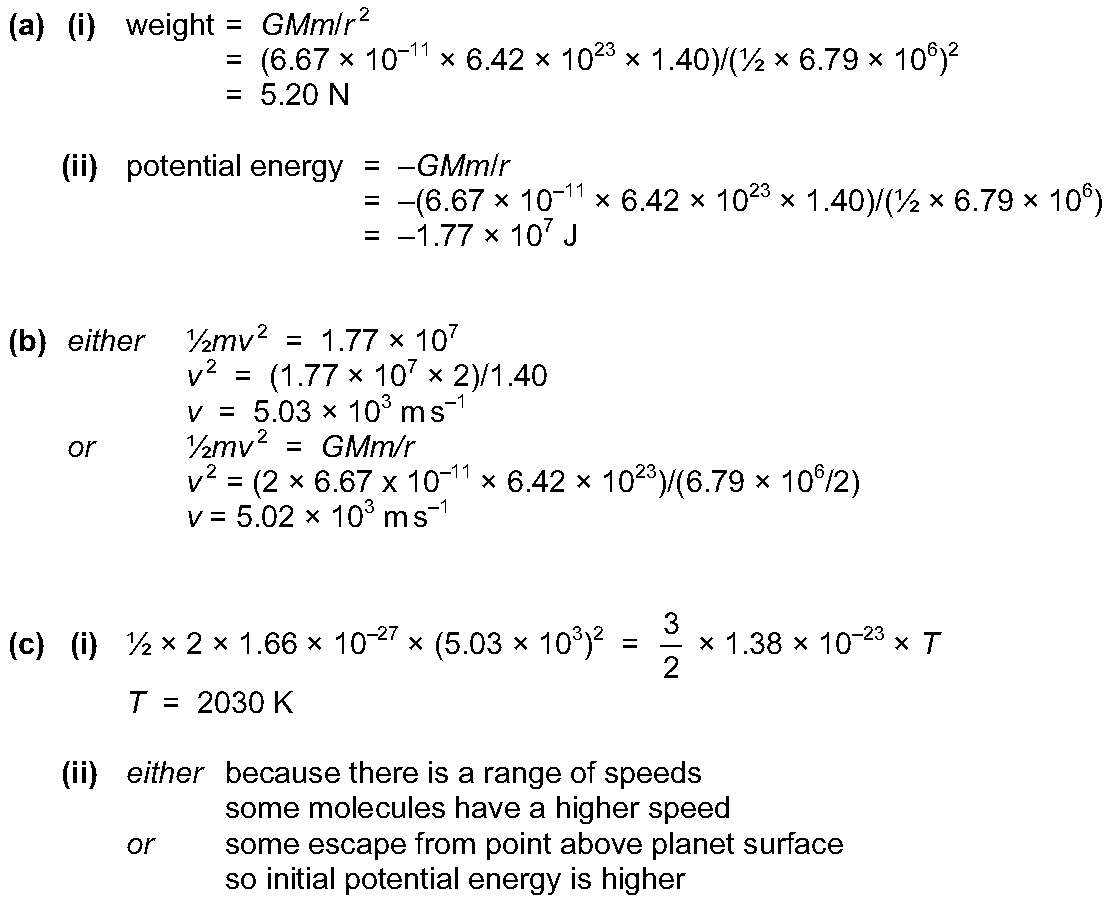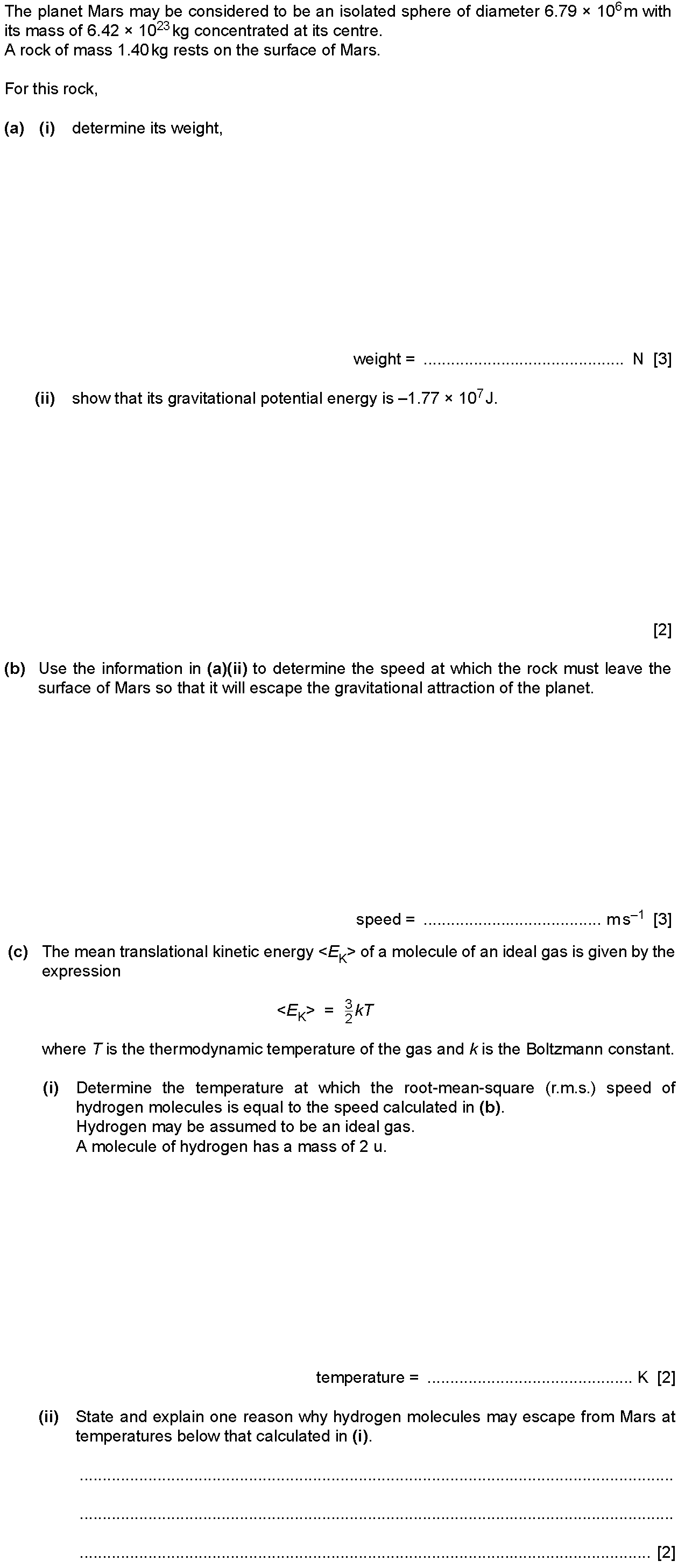Practice Questions:
AS & A Level Physics - 9702 Paper 4 2011 Winter Zone 3
Questions:
1/12

Topic: CH8 - GRAVITATIONAL FIELDS
Solution



PRACTISE
Similar Questions

LEARN
Concepts with Sparky


Related Questions from Similar Topic
Theory
CH8 - GRAVITATIONAL FIELDS
(a) A spherical planet has diameter $1.2 \times 10^4 \text{ km}$. The gravitational field strength at the surface of the planet is $8.6 \text{ N kg}^{...
2009
 Summer
Summer
 Summer
Summer

Theory
CH8 - GRAVITATIONAL FIELDS
The Earth may be considered to be a uniform sphere of radius $R$ equal to $6.4 \times 10^6$ m.
A satellite is in a geostationary orbit.
(a) Describe...
2009
 Winter
Winter
 Winter
Winter

Theory
CH8 - GRAVITATIONAL FIELDS
The Earth may be considered to be a uniform sphere of radius $6.38 \times 10^{3}$ km, with its mass concentrated at its centre.The Global Positioning ...
2009
 Winter
Winter
 Winter
Winter

Theory
CH8 - GRAVITATIONAL FIELDS
(a) Explain what is meant by the potential energy of a body. [2]
(b) Two deuterium ($^2_1H$) nuclei each have initial kinetic energy $E_K$ and are in...
2010
 Summer
Summer
 Summer
Summer

Theory
CH8 - GRAVITATIONAL FIELDS
(a) Define gravitational potential at a point. [2]
(b) The Earth may be considered to be an isolated sphere of radius $R$ with its mass concent...
2010
 Summer
Summer
 Summer
Summer

Theory
CH8 - GRAVITATIONAL FIELDS
(a) Define gravitational field strength. [1]
(b) An isolated star has radius $R$. The mass of the star may be considered to be a point ma...
2010
 Winter
Winter
 Winter
Winter

Theory
CH8 - GRAVITATIONAL FIELDS
(a) Define gravitational field strength.[1]
(b) An isolated star has radius $R$. The mass of the star may be considered to be a point mass at the cen...
2010
 Winter
Winter
 Winter
Winter

Theory
CH8 - GRAVITATIONAL FIELDS
A planet of mass $m$ is in a circular orbit of radius $r$ about the Sun of mass $M$, as illustrated in Figure 1.1.
The magnitude of the angular vel...
2010
 Winter
Winter
 Winter
Winter

Theory
CH8 - GRAVITATIONAL FIELDS
(a) Newton's law of gravitation applies to point masses.
(i) State Newton's law of gravitation. [2]
(ii) Explain why, although the planets and...
2011
 Summer
Summer
 Summer
Summer

Theory
CH8 - GRAVITATIONAL FIELDS
(a) State what is meant by a \textit{field of force}. [1]
(b) Gravitational fields and electric fields are two examples of fields of force. Sta...
2011
 Summer
Summer
 Summer
Summer

More Questions from year 2011
Theory
CH2 - MEASUREMENT TECHNIQUES
Measurements made for a sample of metal wire are shown in Fig. 1.1.
Fig. 1.1
(a) State the appropriate instruments used to make each of these meas...
2011
 Summer
Summer
 Summer
Summer

Theory
Kinetic Energy
(a) Explain what is meant by work done. [1]
(b) A car is travelling along a road that has a uniform downhill gradient, as shown in Fig. 2.1.
...
2011
 Summer
Summer
 Summer
Summer

Theory
CH5 - FORCES, DENSITY & PRESSURE
(a) Explain what is meant by centre of gravity.
(b) Define moment of a force.
(c) A student is being weighed. The student, of weight $W$, stands 0.3...
2011
 Summer
Summer
 Summer
Summer

Theory
CH9 - DEFORMATION OF SOLIDS
(a) Define, for a wire,
(i) stress, [1]
(ii) strain. [1]
(b) A wire of length 1.70 m hangs vertically from a fixed point,...
2011
 Summer
Summer
 Summer
Summer

Theory
CH20 - D.C. CIRCUITS
(a) A variable resistor is used to control the current in a circuit, as shown in Fig. 5.1. The variable resistor is connected in series with a 12V po...
2011
 Summer
Summer
 Summer
Summer

Theory
CH5 - FORCES, DENSITY & PRESSURE
(a) State two assumptions of the simple kinetic model of a gas. [2]
(b) Use the kinetic model of gases and Newton's laws of motion to exp...
2011
 Summer
Summer
 Summer
Summer

Theory
CH15 - SUPERPOSITION
(a) Explain the term interference. [1]
(b) A ripple tank is used to demonstrate interference between water waves.
Describe
(i) the appa...
2011
 Summer
Summer
 Summer
Summer

Theory
CH1 - PHYSICAL QUANTITIES & UNITS
(a) Distinguish between scalar quantities and vector quantities. [2]
(b) In the following list, underline all the scalar quantities.
accelerati...
2011
 Summer
Summer
 Summer
Summer

Theory
CH1 - PHYSICAL QUANTITIES & UNITS
(a) A sphere of radius $R$ is moving through a fluid with constant speed $v$. There is a frictional force $F$ acting on the sphere, which is given by ...
2011
 Summer
Summer
 Summer
Summer

Theory
Potential Energy
(a) (i) Explain what is meant by work done. [1]
(ii) Define power. [1]
(b) Fig. 3.1 shows part of a fairground ride with a carriage on rai...
2011
 Summer
Summer
 Summer
Summer





 0
0
 Share
Share




 Previous
Previous






